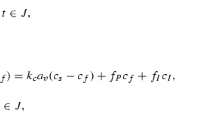Abstract
In this article, we construct a new combined characteristic mixed finite element procedure to simulate the incompressible wormhole propagation. In this procedure, we use the classical mixed finite element method to solve the pressure equation and a modified mass-preserving characteristic finite element method for the solute transport equation, and solve the porosity function straightly by the given concentration. This combined method not only keeps mass balance globally but also preserves maximum principle for the porosity. We considered the corresponding convergence and derive the optimal L2-norm error estimate. Finally, we present some numerical examples to confirm theoretical analysis.




Similar content being viewed by others
References
Zhao, C.: Physical and chemical dissolution front instability in porous media. Springer, Cham (2014)
Daccord, G., Touboul, E., Lenormand, R.: Carbonate acidizing: toward a quantitative model of the wormholing phenomenon. SPE Pro. Eng. 4, 63–68 (1989)
Daccord, G., Lenormand, R., Lietard, O.: Chemical dissolution of a porous medium by a reactive fluid-I. Model for the “wormholing” phenomenon. Chem. Eng. Sci. 48, 169–178 (1993)
Kou, J., Sun, S., Wu, Y.: Mixed finite element-based fully conservative methods for simulating wormhole propagation. Comput. Methods Appl. Mech. Eng. 298, 279–302 (2016)
Wu, Y., Salama, A., Sun, S.: Parallel simulation of wormhole propagation with the Darcy-Brinkman-Forchheimer framework. Comput. Geotech. 69, 564–577 (2015)
Li, X, Rui, H.: Block-centered finite difference method for simulating compressible wormhole propagation. J. Sci. Comput. 74, 1115–1145 (2018)
Li, X, Rui, H.: Characteristic block-centered finite difference method for simulating incompressible wormhole propagation. Comput. Math. Appl. 73, 2171–2190 (2017)
Guo, H., Tian, L., Xu, Z., Yang, Y., Qi, N.: High-order local discontinuous Galerkin method for simulating wormhole propagation. J. Comput. Appl. Math. 350, 247–261 (2019)
Zhang, J., Shen, X., Guo, H., Fu, H., Han, H.: Characteristic splitting mixed finite element analysis of compressible wormhole propagation. Appl. Numer. Math. 147, 66–87 (2020)
Zhang, J.: A new combined characteristic mixed finite element method for compressible miscible displacement problem. Numer. Algorithm. 81, 1157–1179 (2019)
Rui, H., Tabata, M.: A mass-conservative finite element scheme for convection-diffusion problems. J. Sci. Comput. 43, 416–432 (2010)
Li, X., Rui, H., Xu, W.: A new MCC-MFE method for compressible miscible displacement in porous media. J. Comput. Appl. Math. 302, 139–156 (2016)
Zhang, J., Zhang, Y.: A hybrid mixed finite element method for miscible displacement problem with MCC procedure. Appl. Math. Comput. 346, 143–154 (2019)
Wheeler, M.F.: A priori error estimates for Galerkin approximations to parabolic partial differential equations. SIAM J. Numer. Anal. 10, 723–759 (1973)
Ciarlet, P.G.: The finite element methods for elliptic problems. North-Holland, New York (1978)
Brezzi, F., Fortin, M.: Mixed and Hybrid Finite Element Methods. Springer, New York (1991)
Acknowledgments
The authors would like to thank the editor and referees for their valuable comments and suggestions which greatly improved the quality of this paper.
Funding
This work was supported by the Major Scientific and Technological Projects of CNPC (ZD2019-183-008), the Natural Science Foundation of Shandong Province (ZR2019MA015), and the Fundamental Research Funds for the Central Universities (20CX05011A).
Author information
Authors and Affiliations
Corresponding author
Additional information
Publisher’s note
Springer Nature remains neutral with regard to jurisdictional claims in published maps and institutional affiliations.
Rights and permissions
About this article
Cite this article
Zhang, J., Yu, Y., Ji, B. et al. Numerical analysis of incompressible wormhole propagation with mass-preserving characteristic mixed finite element procedure. Numer Algor 89, 323–340 (2022). https://doi.org/10.1007/s11075-021-01116-7
Received:
Accepted:
Published:
Issue Date:
DOI: https://doi.org/10.1007/s11075-021-01116-7
Keywords
- Wormhole propagation
- Mass-preserving
- Maximum principle
- Mixed element method
- The modified characteristic method




